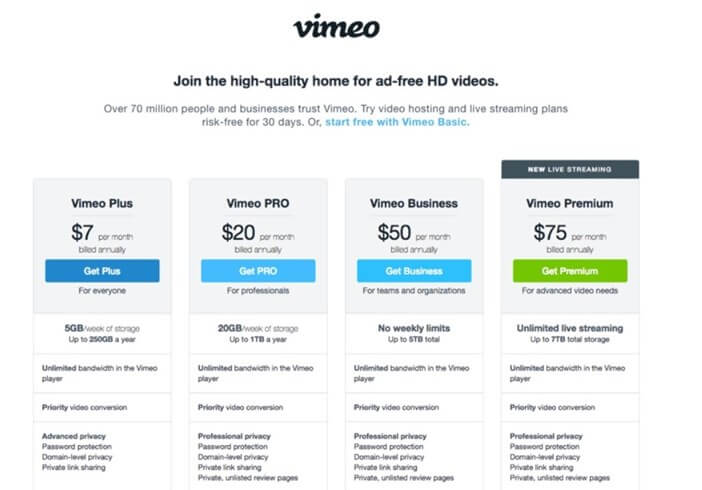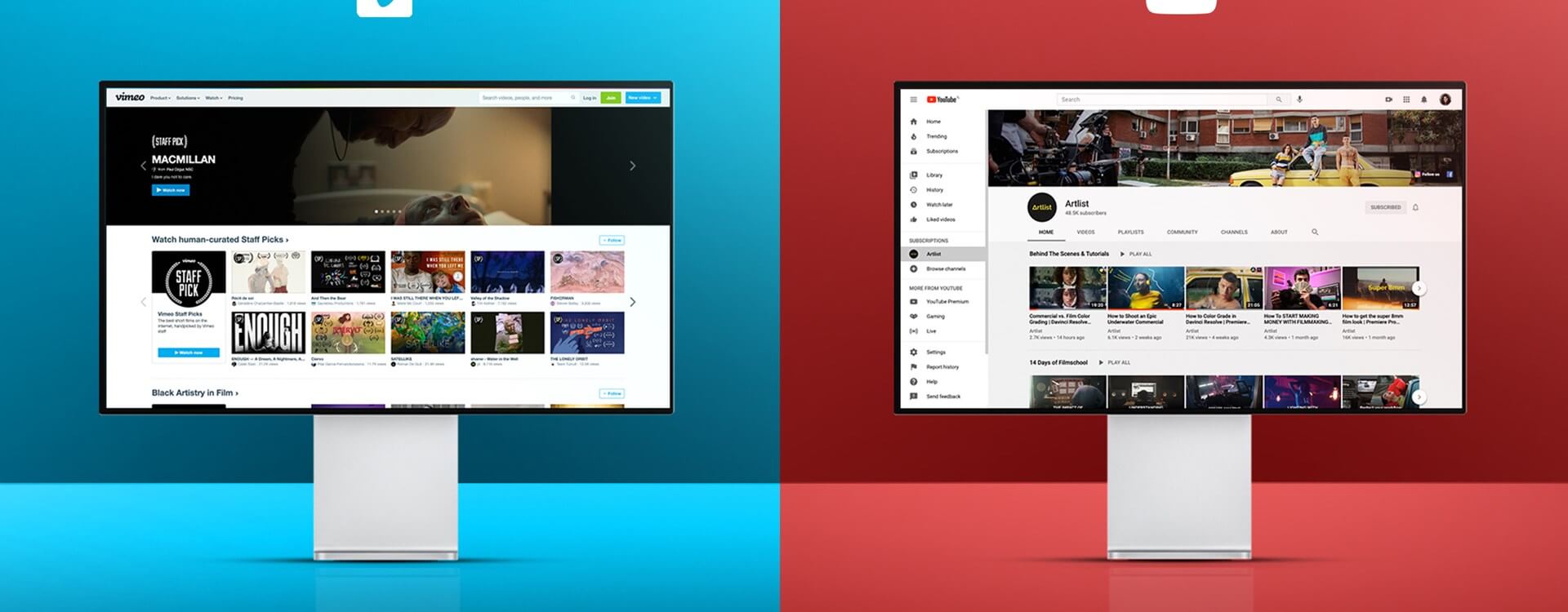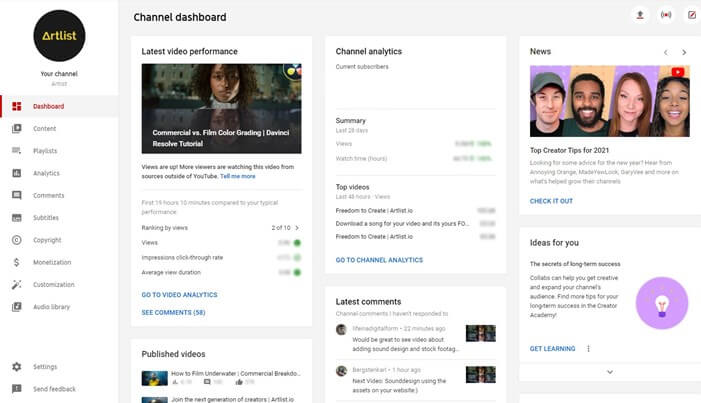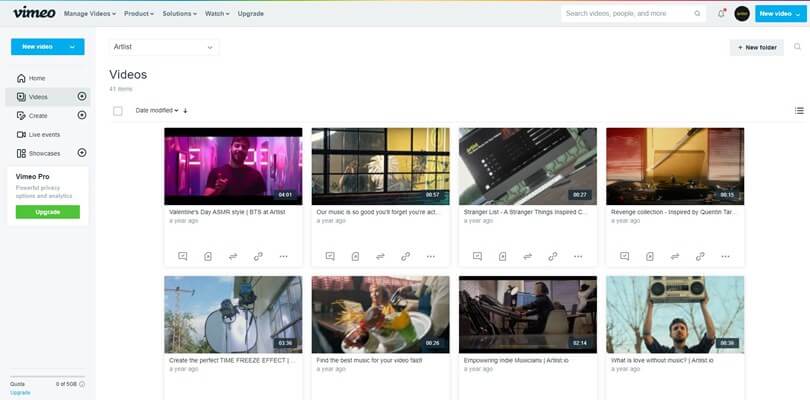Highlights
Table of Contents
Explore article topics
YouTube vs. Vimeo. It’s the video hosting heavyweight title fight that’s been rumbling on for well over a decade now. The question is, which is the right one for you? The answer is not as clear-cut as ‘YouTube is clearly better’ or ‘Vimeo has better features for professionals.’ In order to make a decision, you need to dig into the pros and cons of each site and start thinking about which one is going to suit you and cater to your needs best. Let’s start with YouTube.
Quick YouTube stats
- Founded in 2005
- Headquartered in San Bruno, CA
- Employs 2,000+ people
- It’s the 2nd most visited site in the world
- Ad revenue of $15.4 billion in 2019
- Over 2 billion active monthly users on the platform
- 1 billion videos are watched every day
- 500 hours worth of video uploaded every minute
- The average mobile viewing session is 40 minutes
YouTube pros
- One glance at the quick stats tells you all you need to know. YouTube’s main advantage and obvious selling point is visibility. There are 2 billion(!) active monthly users on the platform. The site is the 2nd most visited on the Internet (behind Google), so the opportunity to have your videos seen and find your audience is huge.
- This is helped massively by the fact that Google owns YouTube. It is often quoted as being ‘the world’s 2nd-largest search engine’ behind, you guessed it, Google.
- The entry point is free. Anyone can sign up very easily without paying anything, and there are no limits on how much or how many videos you can upload to the site.
- Sharing and embedding YouTube videos across other social media platforms and websites is pretty straightforward. The more streamlined you make the sharing process, the more people will watch.
- There are plenty of great tools within the YouTube Studio that can help you really optimize and promote your video. End cards, annotations, keywords, video description, thumbnail choice and tags can all play a key role in having your videos seen by a larger audience.
- Within YouTube Studio, you can also edit your videos by trimming them or making them unlisted and private. Furthermore, when you upload, you have the option to schedule the release time and treat it as a premiere where your audience can tune in live.
YouTube cons
- Once uploaded and released, a video cannot be replaced with a new version without losing all its stats and analytics. This can be frustrating when you have minimal tweaks to make to a video that is already performing very well.
- The number of users on the platform can be a double-edged sword. The wider your fishing net is, the more bad fish you’ll find caught up in it. The same applies to YouTube—the more people who watch, the more comments you receive. Not all of these will be nice. Comments go mostly unmoderated, and you’ll find ugly insults and negative feedback may not be uncommon.
- At the end of the day, YouTube is a product and a business. It needs to make money (especially seeing as it costs you nothing to create an account). Therefore, you’ll see ads everywhere. There are banner ads on the page and popping up at the bottom of the video. Video ads also play at the beginning of the video you want to watch and interrupt your video at random moments. This can be really annoying for your audience.
- Because the entry point to YouTube is so low (the account is free and all you need is a camera), you’re competing with a LOT of other people for attention. In 2021, the market may feel very saturated. The large majority of videos on the site are probably average to below quality. There’s a lot of noise out there, and it can be tough to stand out and have your work seen.
- The viewing habits of your audience are disjointed and broken. It doesn’t take much for them to lose interest and become distracted by something else. The YouTube algorithm doesn’t help this by suggesting videos on the side of yours, enticing them to click away (possibly to a competitor who’s covering something similar to you).
- YouTube video players embedded on your site will display thumbnail links to other videos whenever the player is paused. It could conceivably show a link to one of your competitors; or some other distraction that will take people off your website.
So, that’s YouTube covered. What does the alternative look like over on Vimeo?
Quick Vimeo stats
- Founded in 2004
- Headquartered in New York, NY
- 240 million monthly viewers
- Employs 600 people
- HBO comedy series ‘High Maintenance’ originally started out on Vimeo
- 127th most visited site in the world
- $160 million turnover in 2019
Vimeo pros
- Vimeo is not interested in running adverts right in the middle of your video. Nothing is going to interrupt your audience while they watch it. This leads to less frustration and distractions, meaning there’s more chance of them watching the whole way through.
- Ultimately, this is because Vimeo’s business model is different from YouTube’s. While it’s free to create an account, the real benefits come with the paid accounts (plus, pro, business and premium). These options give you varying degrees of analytic tools, storage, support and customization—features you won’t find on YouTube.
- On Vimeo, you can completely replace a video without losing the stats and analytics. (Yes, please!)
- Unlike the notorious YouTube algorithm (that promotes whoever is getting the most views and doesn’t seem to care about quality), Vimeo promotes its ‘Staff Picks’ – videos chosen by its own staff members for their excellent quality and value.
- This, coupled with the fact that the user base is a lot smaller, means that the overall quality of video on Vimeo is a lot higher than on YouTube. You’ll also find that the audience is a mature community of professionals and like-minded creatives who will offer you some really useful feedback, support and constructive criticism.
- Vimeo’s privacy settings go a few steps further than YouTube’s, giving you detailed control over who can watch and see your videos. You can choose to either password-protect a video or specify which accounts can watch it. This is really useful if you’re looking to share sensitive client work online.
- When it comes to client work, paid tiers also allow your clients to make comments on your work in real-time. For example, if they don’t like the position of the lower thirds text at 01:24, they can leave a comment asking you to change this. This is not unlike services you might get from sites like Wipster or Frame.io.
- Using a service like Vimeo Pro or Business allows you to maximize your video SEO.
Vimeo cons
- Quite clearly, Vimeo metrics are far lower than YouTube’s, whichever way you look at it. The audience is smaller, so you’ll see fewer views. Their videos also perform lower on Google search results (Although, this isn’t necessarily a con, depending on how you’re using it. If you’re using one of the professional features, chances are you’re not concerned with random views anyway but would rather use it to improve SEO rankings).
- Although a basic account is free, this only allows for 500MB of uploads per week. While that may be enough for some of you, it does become annoying if you’re utilizing it a lot. Nobody likes having storage limits imposed on them. To gain access to the premium options that really make Vimeo great, you have to pay. Here’s a breakdown of all the different account options:

- Vimeo does not allow you to place ads and sponsorships in your video – not great for earning money!
Power your business's creativity with Artlist Business
The verdict – what’s right for you?
Now that you’ve weighed up all of the pros and cons, you need to think about which one is best for you. Ultimately, both video-hosting platforms are excellent options and will do a brilliant job for you. Which one is best specifically for you depends on what you need it for.
For example, if you’re looking to reach a large audience and make an impact, potentially setting up a business around your video content that relies heavily on search optimization, ad revenue, sponsorship and engagement (views, likes, comments), YouTube is a no brainer. It’s built to open doors to more opportunities, money and fame (which is why it’s also more competitive). It’s also the place for you If you plan on posting videos on a regular basis in hopes of becoming a full-time YouTuber.
On the other hand, if you’re searching for a creative community where you can really connect with peers and other professionals who you look up to, Vimeo is the one. You can garner some beneficial feedback and constructive criticism that will help you become a better filmmaker while gaining exposure in a particular niche.
For many businesses, you may actually want to use both. Use Vimeo to embed videos on your site and get your website to rank higher on the Google search page video tab. You could also use YouTube to capture traffic from the 2 billion users already hanging out on YouTube that you may want to send to your site.
The choice is yours. Since both are free, there’s absolutely nothing stopping you from using both anyway! It might be your best to start a YouTube channel as well as set up a Vimeo account. It will allow you to play around and tinker with everything to see what feels best.
Josh Edwards is an accomplished filmmaker, industry writing veteran, storyteller based in Indonesia (by way of the UK), and industry writer in the Blade Ronner Media Writing Collective. He's passionate about travel and documents adventures and stories through his films.
Share this article
Did you find this article useful?
Related Posts
- By Kim Wacker
- 6 MIN READ
Latest Posts
- 25 Apr
- By Josh Edwards
- 4 MIN READ


